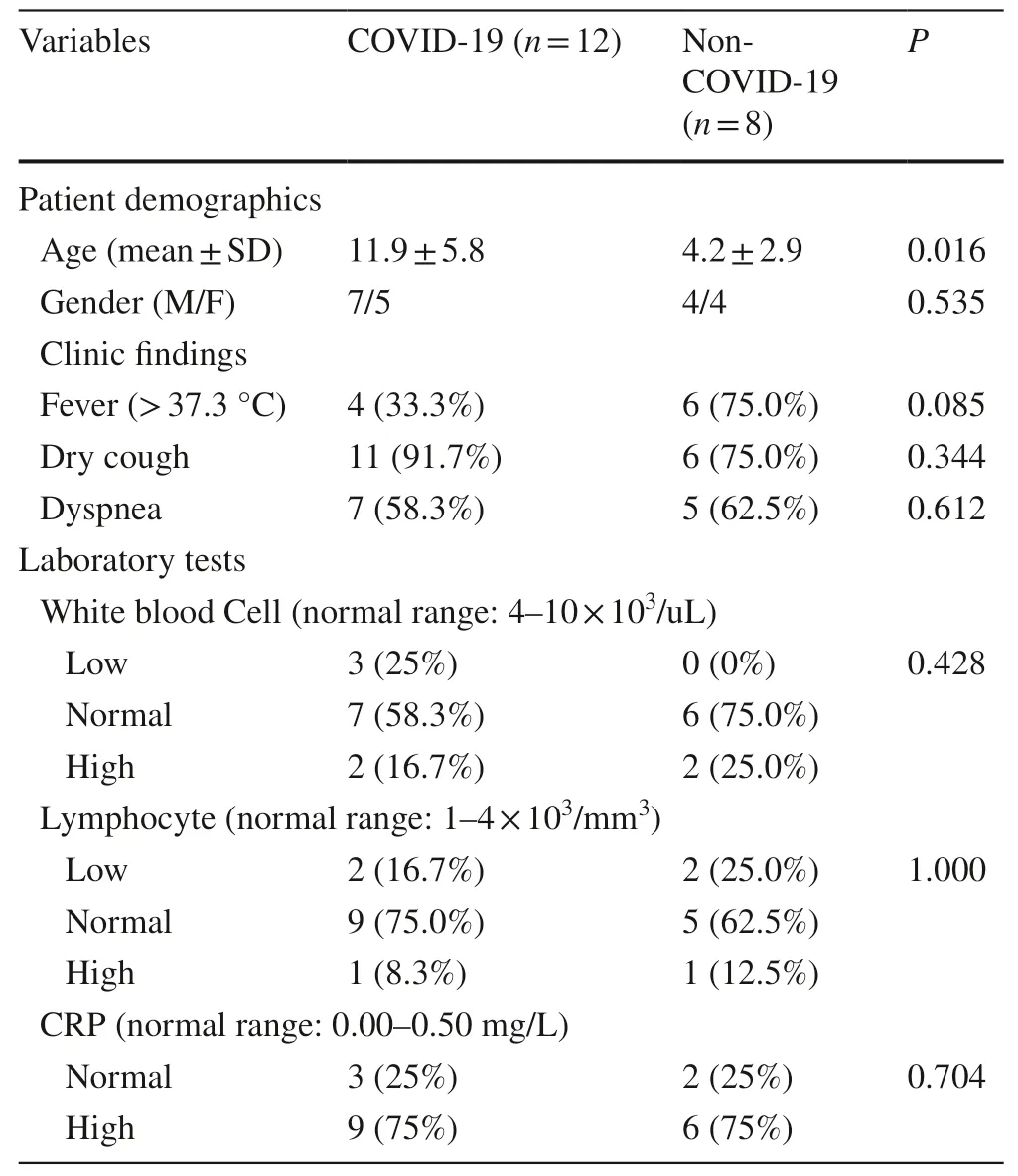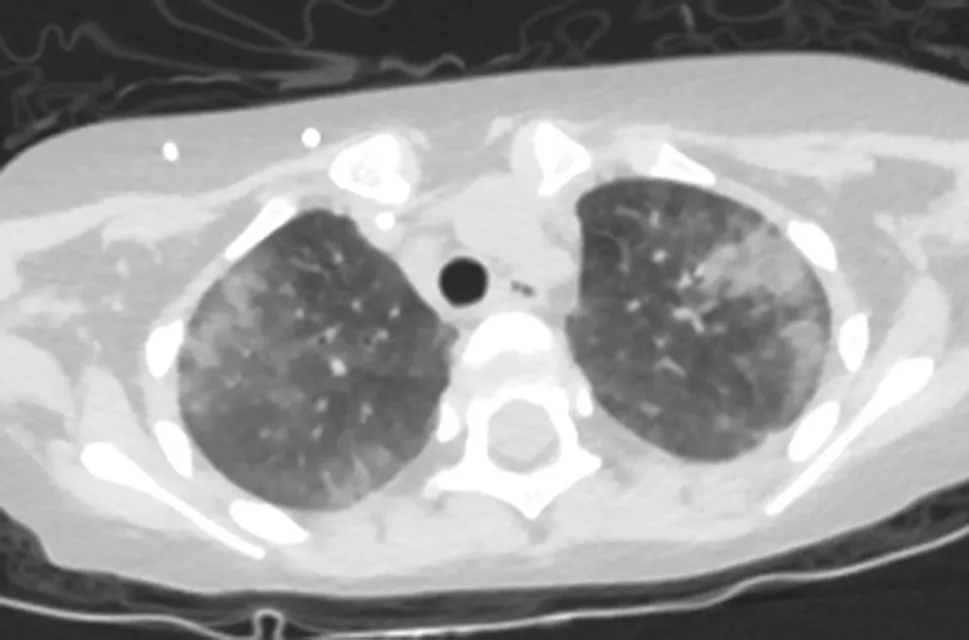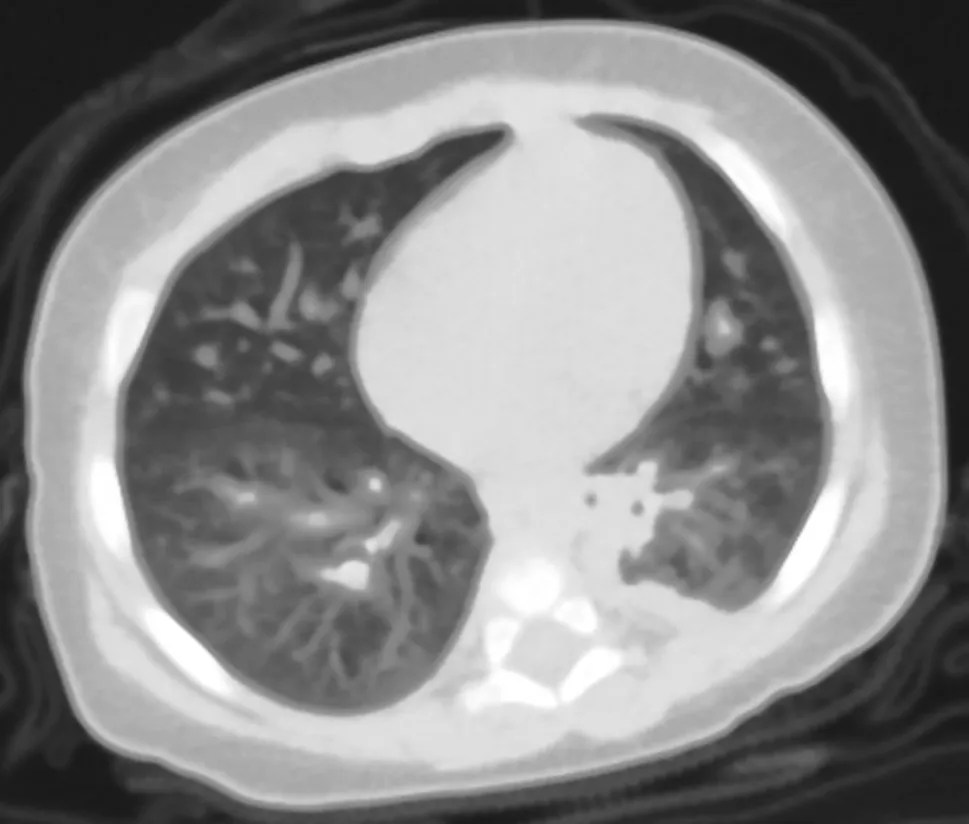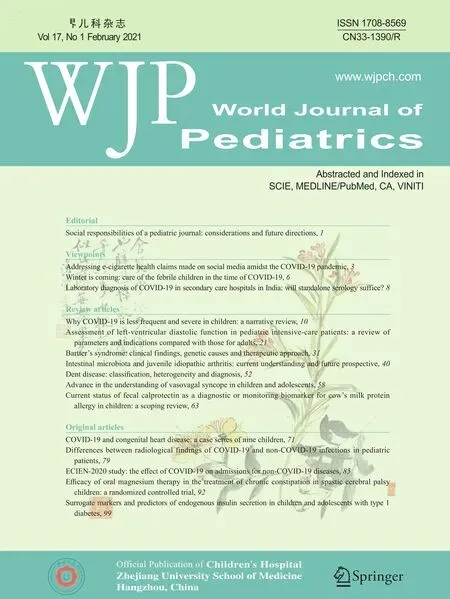Differences between radiological findings of COVID-19 and non-COVID-19 infections in pediatric patients
Beyza Nur Kuzan·Bülent Aslan·Taha Yusuf Kuzan·Ayşegül Karahasan Yağcı·Nuri Çagatay Çimşit
Abstract Background This study aimed to reveal the differences between coronavirus disease 2019 (COVID-19) infections and non-COVID-19 respiratory tract infections in pediatric patients.Methods Sixty pediatric patients admitted to the hospital between March 11,2020 and April 15,2020 with respiratory tract infections were evaluated retrospectively.Among them,20 patients with reverse transcription-polymerase chain reaction(RT-PCR) tests and chest computed tomography (CT) examinations were included in the study.According to the RT-PCR test results,the patients were divided into the COVID-19 and non-COVID-19 groups.The clinical observations,laboratory results,and radiological features from the two groups were then compared.Results According to the RT-PCR test results,12 patients were assigned to the COVID-19 group and 8 to the non-COVID-19 group.There were no significant differences between the two groups in terms of clinical or laboratory features.In terms of radiological features,the presence of bronchiectasis and peribronchial thickening was statistically significantly higher in the non-COVID-19 group (P =0.010 and P =0.010,respectively).Conclusions In pediatric cases,diagnosing COVID-19 using radiological imaging methods plays an important role in determining the correct treatment approach by eliminating the possibility of other infections.
Keywords Chest imaging·Computerized tomography·COVID-19·Pediatric·Pneumonia
Introduction
Early diagnosis and social isolation both play important roles in controlling coronavirus disease 19 (COVID-19)pandemic.For diagnosis,isolating the severe acute respiratory syndrome coronavirus 2 (SARS-CoV-2) with a reverse transcription-polymerase chain reaction (RT-PCR) is the reference test,and lung involvement and its severity can be demonstrated with diagnostic imaging [1].Symptoms in pediatric cases are non-specific,so other respiratory pathogens should be considered in the differential diagnosis [2].In cases suspected for COVID-19,isolation of the causative agent in swab samples is the reference test for diagnosis,but sampling is not always easy in pediatric cases owing to technical limitations.Imaging methods are useful for determining the extent of lung involvement in COVID-19 and making differential diagnoses possible [1,2].
The present study aimed to compare the radiological presentation of lung involvement in COVID-19 and in other respiratory tract infections in pediatric cases confirmed by a laboratory test.
Methods
Patients
This retrospective study was conducted at Marmara University Pendik Training and Research Hospital between March 11th and April 15th,2020.Sixty symptomatic pediatric cases suspected with COVID-19 infection were included into the study.After evaluating the clinical and laboratory results,imaging methods were used in some cases in case of clinical necessity.If radiological imaging was performed in pediatric cases,a posteroanterior (PA) chest radiograph (CXR) was preferred first.If this radiograph is not adequate for diagnosis,patients with at least one of the Ministry of Health’s imaging criteria (fever ≥ 38 °C,respiratory rate ≥ 22/min,saturation of peripheral oxygen (SpO2) ≤ 93% or severe respiratory distress) underwent low-dose chest CT scan [3].
Of the 60 patients admitted to the hospital with symptoms of an upper respiratory tract infection,20 patients with an RT-PCR test for COVID-19,respiratory panel for non-COVID-19 upper respiratory tract infections,and chest CT examination were included in the final analysis.In this study,RT-PCR tests for COVID-19 and respiratory panel tests for non-COVID-19 upper respiratory tract infections were given to all cases.In order to increase the test accuracy rate in the pediatric group,the COVID-19 RT-PCR test was repeated three times;and the cases with at least one positive test were considered COVID-19 positive.According to the test results,the cases were divided into two groups:an RT-PCR test positive infection group (referred to as the COVID-19 group)and an RT-PCR test negative non-infection group (referred to as the non-COVID-19 group).In the non-COVID-19 group,the infectious agent was determined by performing an in-group analysis.This study was approved by the local ethical committee of the hospital (protocol no:09.2020.565).
Image acquisition
The possible effects of radiation exposure on the children were explained in detail and written consent was obtained from their legal guardians.All patients underwent highresolution low-dose chest CT examinations using a 128-CT scanner (Ingenuity Core 128,Philips Healthcare) with exposure parameters of 80—100 kV and 50 mAs,without the use of contrast media.The area between the lung apex and the diaphragm was scanned in the axial plane,in the supine position with free breathing.The resulting images were reconstructed with 1.5 mm and 4 mm collimation.
CT image analysis
The images were evaluated without knowledge of the clinical and laboratory results at a workstation (INFINITT Healthcare Co.,Ltd.) by two radiologists with three and four years of experience and by a senior radiologist with 20 years of pediatric radiology experience.The number,localization,distribution,and appearance of lesions were noted by consensus,along with any other parenchymal and extrapulmonary findings.All chest CT images were classified as typical,indeterminate,atypical,or negative for COVID-19 pneumonia according to Radiological Society of North America(RSNA) classification [4].
Statistical analysis
Descriptive analysis was used to define the characteristics of patients.Continuous random variables were expressed as mean ± standard deviation and categorical variables were expressed as percentages.Two discrete random variables were compared using the chi-square test or Fisher’s exact test.Continuous variables were compared with the Mann—WhitneyUtest.Pvalues of < 0.05 were considered statistically significant.SPSS software (version 17,IBM Corporation) was used for the statistical analysis.
Results
Patients’ clinical data
Six of the 20 patients included in the study were followed up due to a history of previous diseases [neuroblastoma(1),medulloblastoma (2),ataxia-telangiectasia (2),Down syndrome (1)].Twelve of the 20 patients included in the study had a positive RT-PCR test for COVID-19,while eight patients had negative results.Viral or bacterial factors were confirmed by laboratory tests in the eight patients without COVID-19.Epstein—Bar virus (EBV) was indicated as a factor in one patient (12.5%),Methicillinresistant Staphylococcus aureus(MRSA) in one patient(12.5%),rhinovirus/enterovirus in one (12.5%),respiratory syncytial virus (RSV) in two (25.0%),Acinetobacter baumanniiandPseudomonas aeruginosain one (12.5%),and influenza type B in two (25.0%).
The COVID-19 group included 12 pediatric patients aged between two and 17 years (mean ± SD,11.9 ± 5.8 years),and the non-COVID-19 group included eight pediatric patients aged between one and nine years(mean ± SD,4.2 ± 2.9 years) (P=0.016).There were seven males and five females in the COVID-19 group,and four males and four females in the non-COVID-19 group (P=0.535).The demographic data and clinical and laboratory results for the patients are shown in Table 1.
On admission,33.3% (4/12) of the COVID-19 group had a fever,91.7% (11/12) had a dry cough,and 58.3%(7/12) had dyspnea.In the non-COVID-19 group,75.0%(6/8) had a fever,75.0% (6/8) had a dry cough,and 62.5%(5/8) had dyspnea.There was no significant difference in the symptoms of fever,dry cough,and dyspnea from the symptoms on admission of the patients in these two groups (P=0.085,P=0.344,andP=0.612,respectively)(Table 1).
No significant difference was found between the white blood cell (WBC),lymphocyte,and C-reactive protein(CRP) values of the two groups (P=0.428,P=1.00,P=0.704,respectively) (Table 1).

Table 1 Demographic,clinical and laboratory data in cases
CT characteristics
According to the RSNA classification,three cases (25.0%) in the COVID-19 group were typical,four (33.3%) were atypical,and five (41.7%) were negative.No indeterminate cases were detected in this group.In the non-COVID-19 group,one case (12.5%) was typical,four (50.0%) were atypical,and three (37.5%) were negative.Similarly,no indeterminate cases were detected in this group (P=0.851).
We performed a subgroup analysis of seven patients with laboratory-confirmed COVID-19 and an abnormal chest CT and five patients in the non-COVID-19 group who had an abnormal chest CT.The CT results from the COVID-19 and non-COVID-19 subgroups are shown in Table 2.Five (71.4%) of the COVID-19 cases had bilateral lung involvement and two (28.6%) had unilateral lung involvement.The lesions were distributed in the lower zone in five patients (71.4%),in the upper zone in four (57.1%),and in the middle zone in three (42.9%).In five patients (71.4%),the lesions were located peripherally,and in two (28.6%) they were located both peripherally and centrally.Ground-glass opacities (GGO) and fibrous band formations were seen in four cases (57.1%),consolidations,halo signs,and nodules in three (42.9%),and crazy-paving patterns and air bronchograms in two(28.6%).A reticular pattern was observed in one case(14.3%).Evaluation of the CT results showed none of the following parenchymal findings:vascular thickening,air bubble sign,inverse halo sign,mediastinal lymphadenopathy,pericardial effusion,pleural thickening and effusion,emphysema,bronchiectasis and peribronchial thickening,tree-in-bud,cavitation,subpleural curvilinear lines.Chest CT findings of two COVID-19 cases are shown in Figs.1,2.

Table 2 Radiological findings in cases

Fig.1 An eight-year-old laboratory-confirmed male COVID-19 patient presented with cough and respiratory distress upon admission.The chest CT obtained on the second day of symptoms shows consolidation accompanied by peripheral weighted ground glass opacities bilaterally

Fig.2.A 16-month-old laboratory-confirmed male COVID-19 patient was admitted to hospital with fever and cough.The chest CT images obtained on the first day of symptoms showed the presence of consolidation and ground glass opacities bilaterally in the lower lobes
The subgroup analysis showed that bilateral lung involvement was present in all five non-COVID-19 cases (100%),and none had unilateral involvement.Regarding distribution of the lesions,the lower zone was involved in five cases(100%),the upper zone in three (60.0%),and the middle zone in four (80.0%).Lesions were located peripherally in two of the cases (40%) and both peripherally and centrally in three of the cases (60%).GGO were found in five cases(100%),consolidation in four (80.0%),reticular patterns,pleural thickening,the air bubble sign,and a nodule in one(20.0%),air bronchogram and fibrous band formation in three (60.0%),bronchiectasis and peribronchial thickening in four (80%),and pleural effusion in two (40.0%).The evaluation of the CT parenchymal findings showed that vascular thickening,the halo and reverse halo signs,mediastinal lymphadenopathy,pericardial effusion,emphysema,cavitation,and subpleural curvilinear streaking were not detected in any of the cases.Chest CT of a non-COVID-19 patient is shown in Fig.3.
Bronchiectasis and peribronchial thickening were statistically different between the COVID-19 and non-COVID-19 groups (P=0.010 andP=0.010,respectively),although no statistically significant differences were found between the other results (Table 2).
Discussion
Although chest CT imaging plays an important role in the evaluation of pediatric COVID-19 patients,there is limited information regarding the results.Because results of clinical and laboratory tests for COVID-19 are non-specific,imaging modalities significantly improve the diagnostic process.When deciding to use radiological imaging in pediatric patients with suspected COVID-19,the sensitivity and specificity of the examinations,precision and availability of RTPCR tests,radiation dose,and clinical/laboratory findings should be evaluated together [5].This study evaluated pediatric patients with suspected COVID-19 who had clinical tests and CT imaging at the time of their initial admission to hospital.

Fig.3 A five-month-old male patient was admitted to hospital with cough and respiratory distress.Widespread bronchiectasis,peribronchial thickening,and nodular ground glass opacities were observed bilaterally.COVID-19 was excluded with three negative RT-PCR test and respiratory panel tests confirmed the respiratory syncytial virus(RSV)
The results showed no significant difference in symptoms on admission between the COVID-19 case group,which was positive for the SARS-CoV2 by RT-PCR test,and the non-COVID-19 case group,which was negative for the SARSCoV2 by RT-PCR test.In addition,there was no significant difference between the two groups in terms of the measured laboratory parameters,such as WBC,lymphocyte count,and CRP.These results showed the similarities between the two groups in terms of clinical and laboratory results and indicate that isolation of the agent and imaging is necessary for differential diagnosis.
This study found that,from the CT images,the most common abnormalities from seven pediatric patients with positive COVID-19 RT-PCR tests and with abnormal chest CT scans were GGO and/or consolidative opacities bilaterally and peripherally in the lower lobes.This was similar to the results of other studies [2,6].The“halo sign”(GGO surrounding focal consolidation) was seen in three (42.9%)of the COVID-19 positive pediatric patients.In a previous study,Xia et al.found this abnormality in 50% of patients,describing it as an early CT finding in pediatric patients [2].In the present study,the halo sign was seen in patients in the early stages of COVID-19 infection (the first 4 days),although it was not seen in any of the patients in the non-COVID-19 group.However,no significant difference was found between the two groups in terms of the presence of the halo sign.We suggest that the presence of this sign could be studied further in larger patient groups (taking into account clinical considerations) and that more evaluations could be made.
SARS-CoV-2 uses an angiotensin-converting enzyme-2(ACE2) cell receptor when entering human cells [7].This new virus primarily damages the lung interstitium and subsequently causes parenchymal changes [8].This study found that there was a significant difference between bronchiectasis and bronchial wall thickening in COVID-19 and in other viral/bacterial infections.The absence of these two findings in the COVID-19 group supported the pathophysiology as described in the literature.Methicillin-resistant Staphylococcus aureus(MRSA) andAcinetobacter/Pseudomonaswere isolated in one patient,with bronchial wall thickening/bronchiectasis seen on CT images in the non-COVID-19 group,and RSV in two of the patients.MRSA andAcinetobacter/Pseudomonaswere isolated in pediatric patients with known diseases (cystic fibrosis (CF) and ataxia-telangiectasia (AT),respectively),and bronchial wall thickening and bronchiectasis are expected findings on CT images in patients with CF and AT [9— 11].Comparative evaluation of patients with chronic bronchiectasis and detection of new findings are important for evaluation [12].Unlike SARS-CoV-2,RSV is known to cause an airway-centric pattern of disease,leading to moderate bronchial enlargement and bronchial wall thickening.This pattern was found in two patients of the present study and correlates with the results of previous studies [13,14].
Cavitation,tree-in-bud pattern,pleural effusion,and lymphadenopathy have been reported as atypical indicators of COVID-19 on CT images in previous studies [15,16].These abnormalities were not seen on the CT images of any of the patients in this study,and there was no significant difference between COVID-19 and other infectious agents in this regard.This result can be explained by the limited number of patients due to the fact that COVID-19 infection is rarer and milder in children than in adults.In addition,there was no significant difference between the two groups regarding the RSNA classification used to standardize the radiological indications of COVID-19 infection.This may explain why COVID-19 develops differently in children than in adults and the inadequate discrimination between cases [4].
Although the presentation of COVID-19 in the lungs has been described before,the results from CT imaging alone do not have a high level of specificity.Ai et al.[17]found that the sensitivity of chest CT imaging in detecting COVID-19 was reported as 97%,while the specificity was 25% and the accuracy was 68%.Additionally,in that study typical CT findings of COVID-19 infection were seen in 70% of patients with negative RT-PCR tests,and it was found that similar characteristics could be seen in COVID-19 and other viral pneumonias.Similarly,typical indicators of COVID-19 infection according to the RSNA classification were seen on the CT images of one patient in the non-COVID-19 group.However,considering the low specificity of CT in diagnosing COVID-19,it is essential to evaluate the results together with the clinical indications and the reference test for diagnosis (the RT-PCR test).Therefore,the results from chest CT imaging should not be considered as diagnostic criteria alone.There were certain limitations to the present study.First,the small sample size may have affected the reliability of some of the clinical/laboratory tests and CT examinations,and this may have had an effect on the results of the study.The sample size was relatively small because COVID-19 is less frequently seen in children,and they are less likely to be admitted to hospital and undergo CT imaging owing to usually having milder symptoms.The fact that this study used a retrospective approach could be considered to be another limitation.Second,this study used the clinical/laboratory test results,and the CT images of patients on admission and follow-up data were not taken into consideration.The authors believe that investigating this subject in multicentric and larger patient groups will contribute to improving the understanding of the pathophysiology of COVID-19 in pediatric patients.
In conclusion,the results from clinical and laboratory tests for COVID-19 are non-specific in children,and the rate of false-negative results from pharyngeal swab nucleic acid tests used for differentiation from other infectious pathogens is high.For these reasons,chest CT imaging is important for early and accurate diagnosis and for evaluation of complications.Chest CT imaging commonly shows subpleural ground glass opacities and consolidation in children with COVID-19.In addition to these indicators,the absence of peribronchial thickening and bronchiectasis on chest CT images may help to differentiate COVID-19 from pneumonia caused by other respiratory pathogens.
Authors’ contributionsConceptualization:BNK,BA,TYK.Data curation:BNK,BA.Formal analysis:BA,TYK,Methodology:BNK,BA,TYK,AKY and NCS.Supervision:AKY and NCS.Writing—original draft:BNK,BA,TYK,AKY and NCS.Writing—review &editing:BNK,BA,TYK,AKY and NCS.We have seen and approved the final version submitted for publication and take full responsibility for the manuscript.
FundingNone
Compliance with ethical standards
Ethical approval This study was approved by the local ethics committee of Marmara University School of Medicine.
Conflict of interestNo financial or nonfinancial benefits have been received or will be received from any party related directly or indirectly to the subject of this article.
 World Journal of Pediatrics2021年1期
World Journal of Pediatrics2021年1期
- World Journal of Pediatrics的其它文章
- Why COVID-19 is less frequent and severe in children:a narrative review
- Laboratory diagnosis of COVID-19 in secondary care hospitals in India:will standalone serology suffice?
- Winter is coming:care of the febrile children in the time of COVID-19
- Addressing e-cigarette health claims made on social media amidst the COVID-19 pandemic
- Social responsibilities of a pediatric journal:considerations and future directions
- Surrogate markers and predictors of endogenous insulin secretion in children and adolescents with type 1 diabetes
